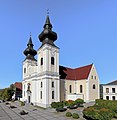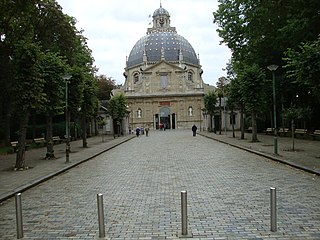
Scherpenheuvel-Zichem is a city and municipality located in the province of Flemish Brabant, Flemish Region, Belgium, encompassing the towns of Averbode, Messelbroek, Okselaar, Scherpenheuvel, Schoonderbuken, Keiberg, Kaggevinne, Testelt and Zichem. On January 1, 2018, Scherpenheuvel-Zichem had a total population of 22,064. The total area is 50.50 km2 which gives a population density of 437 inhabitants per km2.

Melk is a city of Austria, in the federal state of Lower Austria, next to the Wachau valley along the Danube. Melk has a population of 5,257. It is best known as the site of a massive baroque Benedictine monastery named Melk Abbey.

Melk Abbey is a Benedictine abbey above the town of Melk, Lower Austria, Austria, on a rocky outcrop overlooking the Danube river, adjoining the Wachau valley. The abbey contains the tomb of Saint Coloman of Stockerau and the remains of several members of the House of Babenberg, Austria's first ruling dynasty.

The Sanctuary of Our Lady of Lourdes or the Domain is an area of ground surrounding the Catholic shrine (Grotto) to Our Lady of Lourdes in the town of Lourdes, France. The Sanctuary is a destination for pilgrimage; sick pilgrims are reputed to be miraculously healed by Lourdes water. This ground is owned and administered by the Roman Catholic Church, and has several functions, including devotional activities, offices, and accommodation for sick pilgrims and their helpers. The Domain includes the Grotto itself, the nearby taps which dispense the Lourdes water, and the offices of the Lourdes Medical Bureau, as well as several churches and basilicas. It comprises an area of 51 hectares, and includes 22 separate places of worship. There are six official languages of the Sanctuary: French, English, Italian, Spanish, Dutch and German.

Rankweil is a town in the westernmost Austrian state of Vorarlberg, in the district Feldkirch. It is the second largest town in the district Feldkirch and the eighth largest town in Vorarlberg.

Klosterneuburg is a town in Tulln District in the Austrian state of Lower Austria. It has a population of about 27,500. The Klosterneuburg Monastery, which was established in 1114 and soon after given to the Augustinians, is of particular historical importance.
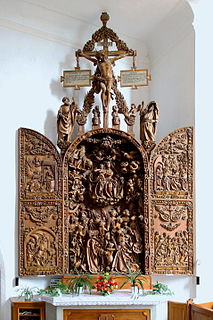
Dunkelsteinerwald is a market municipality with 2,289 inhabitants in the district Melk in Lower Austria, Austria.

Laxenburg is a market town in the district of Mödling, in the Austrian state of Lower Austria. Located about 20 km (12 mi) south of the Austrian capital Vienna, it is chiefly known for the Laxenburg castles, which, beside Schönbrunn, served as the most important summer retreat of the Habsburg monarchs.

Mariazell is an Austrian city in the southeastern state of Styria. Well known for being a hub of winter sports and a pilgrimage destination, it is located 143 kilometres north of Graz. It is picturesquely situated in the valley of the Salza, amid the north Styrian Alps.
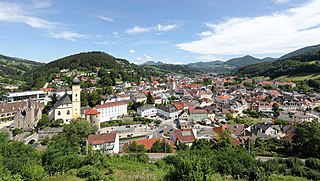
Waidhofen an der Ybbs is a statutory city (Statutarstadt) in the Austrian state of Lower Austria. The city had a population of 11,662 as of the 2001 census. It was first mentioned in 1186 and has been the economic centre of the Ybbstal valley since the 14th century.

Marija Bistrica is a village and municipality in the Krapina-Zagorje County in central Croatia, located on the slopes of the Medvednica mountain in the Hrvatsko Zagorje region north of the capital Zagreb. The municipality has 5,976 inhabitants, with 1,071 residents in the settlement itself.

Hall in Tyrol is a town in the Innsbruck-Land district of Tyrol, Austria. Located at an altitude of 574 m, about 5 km (3 mi) east of the state's capital Innsbruck in the Inn valley, it has a population of about 13,000.

Mariazell Basilica, also known as Basilica Mariä Geburt, is a Roman Catholic church building in Mariazell, Austria. It is the most important pilgrimage destination in Austria and one of the most visited shrines in Europe. In the church, a miraculous wooden image of the Virgin Mary is venerated.

Tamsweg is a market town in the Austrian state of Salzburg near the border with Styria. It is the administrative centre of the eponymous Tamsweg District (Bezirk) and the largest town of the Salzburg Lungau region.
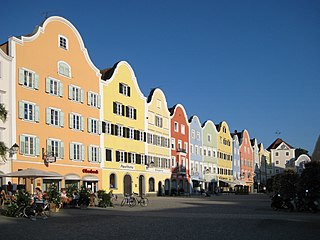
Schärding is a town in northern Austrian state of Upper Austria, the capital of the district of the same name, and a major port on the Inn River. Historically, it was owned by the Wittelsbach family, which reflects in the town's architecture.

Obervellach is a market town in the district of Spittal an der Drau, in the Austrian state of Carinthia.

Mautern an der Donau is a town in the district of Krems-Land in the Austrian state of Lower Austria.

Maria Schmolln is a municipality in the district of Braunau am Inn of the Austrian state of Upper Austria state. The community is mainly known as an important pilgrimage destination among rural Innviertel. The name comes from its location on the “Schmollner Berg”, literally small mountain.
Burgau is a municipality in the district of Hartberg-Fürstenfeld in Styria, Austria. It is in the south-east of the country, near the border with Hungary.

The Wachau is an Austrian valley with a picturesque landscape formed by the Danube river. It is one of the most prominent tourist destinations of Lower Austria, located midway between the towns of Melk and Krems that also attracts "connoisseurs and epicureans" for its high-quality wines. It is 36 kilometres (22 mi) in length and was already settled in prehistoric times. A well-known place and tourist attraction is Dürnstein, where King Richard the Lionheart of England was held captive by Duke Leopold V of Austria and Styria. The architectural elegance of its ancient monasteries, castles and ruins combined with the urban architecture of its towns and villages, and the cultivation of vines as an important agricultural produce are the dominant features of the valley.




